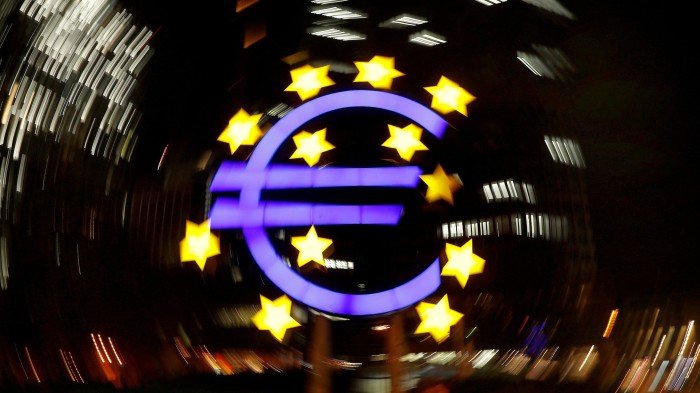Unlock the Editor’s Digest for free
Roula Khalaf, Editor of the FT, selects her favourite stories in this weekly newsletter.
The writer is chief economist at ING
The dollar is losing its status as an all-purpose haven, highlighted by Moody’s recent downgrade of its last remaining triple A credit rating from one of the big three agencies. The EU now has a unique chance to capitalise on investor doubts and promote the euro as a reserve currency, a move that would yield significant economic benefits. It is time to break the taboo around issuing common debt by the EU backed by member states.
The dollar’s decline is partly due to President Donald Trump’s trade and budget policies, but there is a structural shift too: foreign holdings of US debt dropped from 50 per cent of the outstanding debt pile in 2014 to only a third by 2024. Meanwhile, foreign interest in European bonds, especially German Bunds, is rising: over the years 2023 and 2024, foreign holders increased their holdings by about €160bn, the equivalent of 8 per cent of currently outstanding Bunds.
The EU should accelerate this trend for two reasons. First, greater demand for euros means cheaper borrowing costs for the bloc’s governments, corporations and homeowners. The Bank for International Settlements found that $100bn in foreign purchases of US Treasuries lowered interest rates by 0.20 percentage points using conservative estimates, illustrating the substantial beneficial impact of having increased foreign holdings.
Second, positioning the euro as an alternative haven brings stability during downturns. In times of economic stress, a flight to euro assets would lower financing costs for European governments, giving them more fiscal ammunition to stabilise their economies. At moments such as that, European banks would also receive a boost in the value of their government debt assets, breaking the bank-sovereign “doom loop” that spooked markets during the Eurozone crisis of the early 2010s when sell-offs in national debt weakened bank securities and vice versa. More resilience in a crisis would allow lenders to continue to support the real economy, rather than break it at the worst possible moments.
To capitalise on this singular historical moment, Europe needs to act fast. Playing a stronger role as a haven requires increased availability of safe assets. This includes both highly rated national government bonds but also Eurozone bonds backed by member states and issued at a predictable rate.
For some governments, particularly those with lower debt-GDP ratios, Eurozone bonds are rife with moral hazard: they fear that backing common debt would merely encourage more profligate peers to freeload and keep spending. That is a fair criticism — but opposing Eurozone bonds outright would mean missing out on a much bigger opportunity that would benefit frugal countries.
One way to mitigate improvidence is to make Eurozone bonds conditional. For example, they could replace national debt, rather than add to the overall stock. As Hélène Rey, professor of economics at London Business School, has argued: there is no need to run very high government deficits to be the world’s reserve currency. It is about a sufficiently large stock of debt being available. As it happens, here in Europe there is a bountiful stock at our hands that common bonds could replace. A stronger restriction on breaking the EU rule that government deficits should not exceed 3 per cent deficit to GDP as part of the plan would lower the moral hazard risks.
Even with conditionalities, there may be concerns among stakeholders in Finland, the Netherlands and Germany that issuing debt together with, say, Italy and Greece, would increase their individual government borrowing costs. However, this perspective is unduly pessimistic. European institutions already issue debt with a triple A rating, which is superior to the median government rating of low double A.
Furthermore, if European governments jointly finance a small portion of their debt — for example, the first 10 per cent — this implies risk pooling. Consequently, this would reduce the overall risk associated with European sovereign debt, and potentially lead to improved ratings for all national governments. In addition, increased liquidity and regular issuance of Eurozone bonds can result in their inclusion in sovereign indices and help grow a futures market.
This brings us back to the overall impact on financing costs. For context, the EU at present pays a premium of 0.15 to 0.20 percentage points to finance itself for seven to 10 years versus the Dutch government. The increased popularity at home and abroad could easily bring future common financing costs below the current price paid by a relatively frugal country such as the Netherlands. Needless to say that the southern EU countries may benefit more — an impact that would indirectly also benefit the rest as the internal market would grow faster.
The economic case is clear for the EU to begin to design acceptable frameworks for issuing Eurozone bonds if it wishes to capitalise on US weakness.

